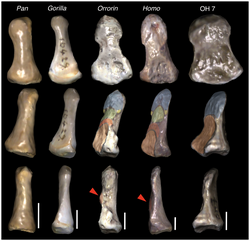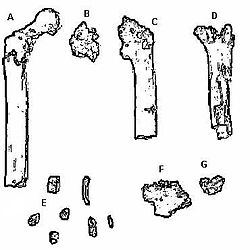Distal-phalanges-thumb-index Journal.pone.0011727.g001
Autor:
Almécija, Moyà-Solà & Alba
Přisuzování:
Obrázek je označen jako „Vyžadováno uvedení zdroje“ (Attribution Required), ale nebyly uvedeny žádné informace o přiřazení. Při použití šablony MediaWiki pro licence CC-BY byl pravděpodobně parametr atribuce vynechán. Autoři zde mohou najít příklad pro správné použití šablon.
Shortlink:
Zdroj:
Formát:
2868 x 2543 Pixel (3686674 Bytes)
Popis:
Modern human thumb and index finger (right hand) during pad-to-pad precision grasping in ulnar view. The box shows the anatomy of the pollical distal phalanx and its relationship with soft structures related to refined manipulation: a huge proximopalmar fossa (orange), associated with a palmarly protruding ridge (red) for insertion of the flexor pollicis longus; a compartmentalized digital pulp to accommodate the shape of the object being manipulated; this is reflected in the presence of an ungual fossa (green), associated to the large and mobile proximal pulp, as well as a wide apical tuberosity associated with the smaller and less mobile distal pulp; and finally, the ungual spines (yellow), where the collateral intraosseous ligaments that sustain the nail bed insert.
Komentář k Licence:
"2010 Almécija et al. This is an open-access article distributed under the terms of the Creative Commons Attribution License, which permits unrestricted use, distribution, and reproduction in any medium, provided the original author and source are credited."
Licence:
Credit:
Almécija S, Moyà-Solà S, Alba DM (2010) Early Origin for Human-Like Precision Grasping: A Comparative Study of Pollical Distal Phalanges in Fossil Hominins. PLoS ONE 5(7): e11727. doi:10.1371/journal.pone.0011727
Relevantní obrázky
Relevantní články
Orrorin tugenensisOrrorin tugenensis je druh vyhynulých hominidů, žijící ve svrchním miocénu na území dnešní Keni ve východní Africe. Vývojově stojí velmi blízko poslednímu společnému předku moderních šimpanzů a lidí a možná již patří přímo k lidské vývojové linii. Pokud je tomu tak, je po rodu Sahelanthropus druhým nejstarším zástupce této větve. Předchází mladším homininům, jako jsou Ardipithecus a Australopithecus. .. pokračovat ve čtení









